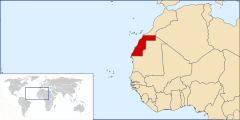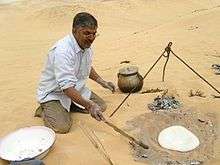Western Saharan cuisine



Western Saharan cuisine comprises the cuisine of Western Sahara, a disputed territory in the Maghreb region of North Africa, bordered by Morocco to the north, Algeria to the extreme northeast, Mauritania to the east and south, and the Atlantic Ocean to the west. The Western Saharan cuisine has several influences, as the population of that area (Sahrawi), in their most part are of Arabic and Berber origin. The Saharawi cuisine is also influenced by Spanish cuisine owing to Spanish colonisation.
Food is primarily imported into Western Sahara, as minimal rainfall in the territory inhibits agricultural production.[1] Indigenous sources of food include those derived from fishing and nomadic pastoralism.[1][2] The labor and business in these indigenous provisions of foods are also a primary contributor of income for the territory's population, and are among the primary contributors to the economy of Western Sahara.[1][2]
A major staple food is the couscous that often accompanies one way or another all the food dishes. The influences of southern cuisine makes them consume peanut as an accompaniment of some dishes.
For meat, the Sahrawis favour the camel and goat; pork is not eaten, since it is not halal. Lamb also occupies a prominent place. Some tribes are famous for growing wheat, barley and cereals in general.
Some fruits and vegetables are grown in oases that are scattered within the territory.[2]
As of 2012, all economic activity and trade in Western Sahara is governed by the government of Morocco.[2]
Common foods and dishes
Being almost entirely nomadic, the diet of Saharan tribes was based mainly on meat, milk and derivatives. The coastal tribes added to this diet fish dishes, rice and so on.
- Couscous, meal paste, with meat and vegetables[3][4]
- Tajín, camel meat [5][6][7]
- Made solely from Dromedaries
- Goat meat [6]
- Meifrisa is a traditional dish of the region.[8] It's a stew prepared with rabbit, lamb or camel meat, onion, and garlic, served atop unleavened bread cooked in the sand.[8]
- Ezzmit, cereals.
- El aych, cereals with milk.
- Arroz con pescado.
- Various types of roasts.
Beverages
- It is very usual intake of tea. Tea is more than just a drink for the Saharawi people. It is a way to meet with friends and family to share moments of conversation and friendship.
It usually follows a ritual, in which are taken three vessels. In this regard, there is a popular comment: "The first glass of tea is bitter like life, the second cup sweet like love and the third soft as death."[3]
- Camel milk [9]
- milked solely from Dromedaries
- Goat milk [10]
See also
References
- 1 2 3 The World Factbook 2008
- 1 2 3 4 Western Sahara Business Law Handbook: Strategic Information and Laws - Ibpus.com, International Business Publications, USA
- 1 2 International Mission Board: News & Information
- ↑ Endgame in the Western Sahara: What Future for Africa's Last Colony? - Toby Shelley. pp. 82-83.
- ↑ Camel Meat and Meat Products
- 1 2 The 37-year-old refugee situation you know nothing about | PBS NewsHour
- ↑ Western Sahara: Anatomy of a Stalemate - Erik Jensen. p. 23.
- 1 2 "Western Sahara". Foodspring.
- ↑ The next thing: camel milk
- ↑ The Western Sahara and the Frontiers of Morocco - Robert Rézette. pp. 25-33.
Further reading
- Crossette, Barbara (June 9, 2001). "World Briefing, Africa: Western Sahara: Refugees Need Food". The New York Times. Retrieved 29 January 2014.
- Sahara Press Service (February 3, 2013). "Morocco: Swedish Food Chains Unite in Avoiding Occupied Western Sahara's Goods". All Africa. Retrieved 29 January 2014.
- Sahara Press Service (April 16, 2013). "Western Sahara: Over 20 Tonnes of Food Aid to Saharawi Refugees". All Africa. Retrieved 29 January 2014.
External links
- "Places to eat in Western Sahara". Virtual Tourist.